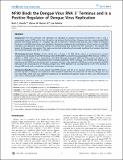| dc.contributor.author | Gomila, Raul C. | |
| dc.contributor.author | Martin, Glover W., III | |
| dc.contributor.author | Gehrke, Lee | |
| dc.date.accessioned | 2011-09-27T20:47:41Z | |
| dc.date.available | 2011-09-27T20:47:41Z | |
| dc.date.issued | 2011-02 | |
| dc.date.submitted | 2010-10 | |
| dc.identifier.issn | 1932-6203 | |
| dc.identifier.uri | http://hdl.handle.net/1721.1/66086 | |
| dc.description.abstract | Background
Viral RNA translation and replication are regulated by sequence and structural elements in the 5′ and 3′ untranslated regions (UTR) and by host cell and/or viral proteins that bind them. Dengue virus has a single-stranded RNA genome with positive polarity, a 5′ m7GpppG cap, and a conserved 3′-terminal stem loop (SL) that is linked to proposed functions in viral RNA transcription and translation. Mechanisms explaining the contributions of host proteins to viral RNA translation and replication are poorly defined, yet understanding host protein-viral RNA interactions may identify new targets for therapeutic intervention. This study was directed at identifying functionally significant host proteins that bind the conserved dengue virus RNA 3′ terminus.
Methodology/Principal Findings
Proteins eluted from a dengue 3′ SL RNA affinity column at increasing ionic strength included two with double-strand RNA binding motifs (NF90/DRBP76 and DEAH box polypeptide 9/RNA helicase A (RHA)), in addition to NF45, which forms a heterodimer with NF90. Although detectable NF90 and RHA proteins localized to the nucleus of uninfected cells, immunofluorescence revealed cytoplasmic NF90 in dengue virus-infected cells, leading us to hypothesize that NF90 has a functional role(s) in dengue infections. Cells depleted of NF90 were used to quantify viral RNA transcript levels and production of infectious dengue virus. NF90 depletion was accompanied by a 50%-70% decrease in dengue RNA levels and in production of infectious viral progeny.
Conclusions/Significance
The results indicate that NF90 interacts with the 3′ SL structure of the dengue RNA and is a positive regulator of dengue virus replication. NF90 depletion diminished the production of infectious dengue virus by more than 50%, which may have important significance for identifying therapeutic targets to limit a virus that threatens more than a billion people worldwide. | en_US |
| dc.description.sponsorship | Ruth L. Kirschstein National Research Service Award (NIH-NRSA GM64985) | en_US |
| dc.description.sponsorship | UNCF-Merck Postdoctoral Fellowship | en_US |
| dc.description.sponsorship | National Institute of Allergy and Infectious Diseases (U.S.) | en_US |
| dc.description.sponsorship | Ellison Medical Foundation | en_US |
| dc.language.iso | en_US | |
| dc.publisher | Public Library of Science | en_US |
| dc.relation.isversionof | http://dx.doi.org/10.1371/journal.pone.0016687 | en_US |
| dc.rights | Creative Commons Attribution | en_US |
| dc.rights.uri | http://creativecommons.org/licenses/by/2.5/ | en_US |
| dc.source | PLoS | en_US |
| dc.title | NF90 Binds the Dengue Virus RNA 3′ Terminus and is a Positive Regulator of Dengue Virus Replication | en_US |
| dc.type | Article | en_US |
| dc.identifier.citation | Gomila, Raúl C., Glover W. Martin, and Lee Gehrke. “NF90 Binds the Dengue Virus RNA 3′ Terminus and Is a Positive Regulator of Dengue Virus Replication.” Ed. Kylene Kehn-Hall. PLoS ONE 6 (2)(2011): e16687. © 2011 Gomila et al. | en_US |
| dc.contributor.department | Harvard University--MIT Division of Health Sciences and Technology | en_US |
| dc.contributor.approver | Gehrke, Lee | |
| dc.contributor.mitauthor | Gomila, Raul C. | |
| dc.contributor.mitauthor | Gehrke, Lee | |
| dc.relation.journal | PLoS ONE | en_US |
| dc.eprint.version | Final published version | en_US |
| dc.type.uri | http://purl.org/eprint/type/JournalArticle | en_US |
| eprint.status | http://purl.org/eprint/status/PeerReviewed | en_US |
| dspace.orderedauthors | Gomila, Raúl C.; Martin, Glover W.; Gehrke, Lee | en |
| dc.identifier.orcid | https://orcid.org/0000-0002-9387-8212 | |
| mit.license | PUBLISHER_CC | en_US |
| mit.metadata.status | Complete | |
